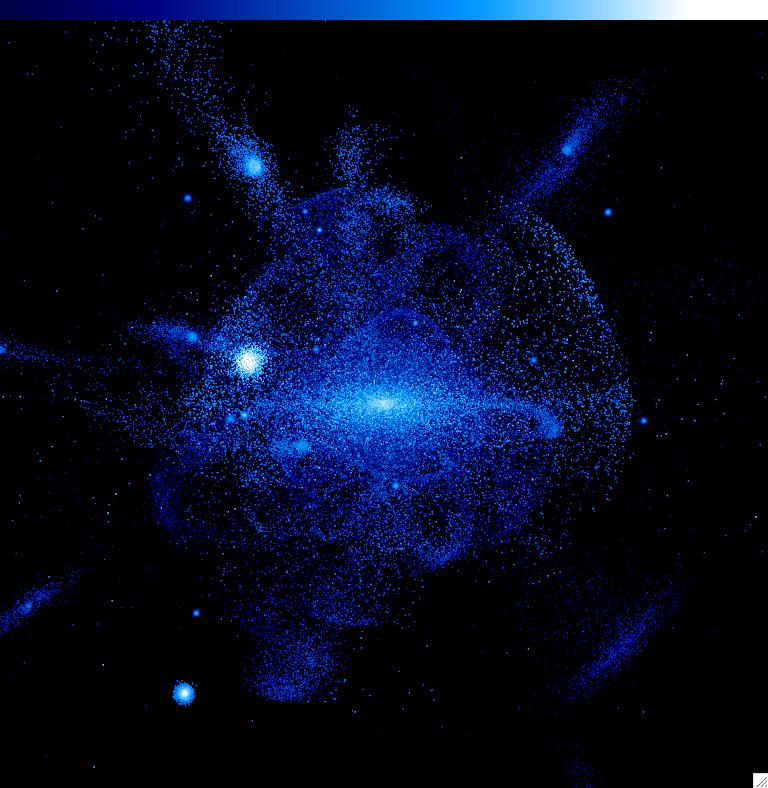
The structures seen in the SDSS-II star maps support this prediction of a complicated outer Galaxy. The region shown is about one million light years on a side; the sun is just 25,000 light years from the center of the Galaxy and would appear close to the center of this picture.
The halo of stars that envelops the outer Milky Way galaxy is like a "jumble of pasta" said one researcher, describing criss-crossed patterns of stellar streams revealed in new data from the Sloan Digital Sky Survey (SDSS). These stars appear to have been ripped away from the dwarf galaxies that are companions to our own galaxy, creating messy, spaghetti-like streams of stars in the outer edge of the Milky Way. The SEGUE (Sloan Extension for Galactic Understanding and Exploration) of the Sloan Survey is mapping the structure and stellar makeup of the Milky Way Galaxy and has found numerous new small streams of stars mixed and tangled among larger streams that had been mapped out over the last decade. It appears the Milky Way's thievery is creating quite a mess.
While the center of galaxy is quite orderly, the outer Milky Way is a cluttered mess. Kathryn Johnston from Columbia University explained how dwarf galaxies that pass close to the Milky Way can be stretched by gravitational tides into spaghetti-like strands, which wind around the Galaxy as stars trace out the same orbital paths at different rates.
"In the center of the Galaxy, these stellar strands crowd together and you just see a smooth mix of stars," said Johnston. "But as you look further away you can start to pick out individual strands, as well as features more akin to pasta shells that come from dwarfs that were on more elongated orbits." Johnston described the new smaller strands recently detected as "angel hair" that came from smaller dwarf or ones that were destroyed longer ago.
Heidi Newberg of Rensselaer Polytechnic Institute and her thesis student Nathan Cole have been trying to follow some of the larger strands as they weave across the sky. "It's a big challenge to piece things together," said Cole, "because the stream from one dwarf galaxy can wrap around the Galaxy and pass through streams of stars ripped from other dwarf galaxies."
Toward the constellation Virgo, where SDSS images revealed an excess of stars covering a huge area of sky, there are at least two superposed structures, and possibly three or more. The SEGUE velocity measurements can separate systems that overlap in sky maps, Newberg explained. "Part of what we see toward Virgo is a tidal arm of the Sagittarius dwarf galaxy, whose main body lies on the opposite side of the Milky Way, but we don't know the origin of the other structures. There really aren't enough pasta varieties to describe all the structures we find."
"The SDSS has taught us a huge amount about the Milky Way and its neighbors," said Johnston. "But we're still just beginning to map the Galaxy in a comprehensive way, and there's a trove of discoveries out there for the next generation of surveys, including the two new Milky Way surveys that will be carried out in SDSS-III," the next set of surveys slated for Sloan.
While the center of galaxy is quite orderly, the outer Milky Way is a cluttered mess. Kathryn Johnston from Columbia University explained how dwarf galaxies that pass close to the Milky Way can be stretched by gravitational tides into spaghetti-like strands, which wind around the Galaxy as stars trace out the same orbital paths at different rates.
"In the center of the Galaxy, these stellar strands crowd together and you just see a smooth mix of stars," said Johnston. "But as you look further away you can start to pick out individual strands, as well as features more akin to pasta shells that come from dwarfs that were on more elongated orbits." Johnston described the new smaller strands recently detected as "angel hair" that came from smaller dwarf or ones that were destroyed longer ago.
Heidi Newberg of Rensselaer Polytechnic Institute and her thesis student Nathan Cole have been trying to follow some of the larger strands as they weave across the sky. "It's a big challenge to piece things together," said Cole, "because the stream from one dwarf galaxy can wrap around the Galaxy and pass through streams of stars ripped from other dwarf galaxies."
Toward the constellation Virgo, where SDSS images revealed an excess of stars covering a huge area of sky, there are at least two superposed structures, and possibly three or more. The SEGUE velocity measurements can separate systems that overlap in sky maps, Newberg explained. "Part of what we see toward Virgo is a tidal arm of the Sagittarius dwarf galaxy, whose main body lies on the opposite side of the Milky Way, but we don't know the origin of the other structures. There really aren't enough pasta varieties to describe all the structures we find."
"The SDSS has taught us a huge amount about the Milky Way and its neighbors," said Johnston. "But we're still just beginning to map the Galaxy in a comprehensive way, and there's a trove of discoveries out there for the next generation of surveys, including the two new Milky Way surveys that will be carried out in SDSS-III," the next set of surveys slated for Sloan.




Comment